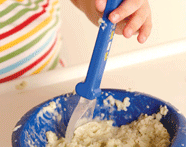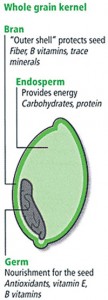Sweetpea goes for whole grains!

There’s an array of tasty whole grains available to you and your little one that are chock full of nutrition. However, determining what is really a whole grain and what is not is still tricky, but here’s some basic information that will help you appreciate the benefits of whole grains. Let’s start by breaking down the whole grain into its three parts, the bran, the germ and the endosperm and understanding the nutritional value of each:
• The Bran is the outer shell of the grain and is rich in fiber, B vitamins and trace minerals
• The Germ, the inner part of the grain, is also rich in B vitamins, vitamin E, unsaturated fat and phytochemicals (plant chemicals that prevent disease);
• The Endosperm contains carbohydrates, some protein and B vitamins.
Common examples of whole grains are quinoa, bulgur, brown rice, whole wheat flour, oatmeal and millet.
Since a picture is worth a thousand words, here’s one for you:
Unfortunately, when whole grains are processed to create white flour, white rice or white pasta, two of the nutritional parts, the bran and the germ, are stripped down leaving behind just the endosperm, thus eliminating a majority of the nutrition that is initially in the whole grain. The over-consumption of this white flour has been linked to Type II diabetes, obesity and blood sugar fluctuations.
In Canada, through a process called fortification, manufacturers are required to enrich white processed flour with vitamins and iron. However, you can’t exactly mimic nature so it is nearly impossible to make a grain whole from one that has been refined.
Fortified grains still lack some precious nutrients and fiber that are essential parts of optimal health and development.
Grains and your baby
For the first six months of life, breast milk is best for your baby. At approximately six months of age, your little one is ready to start with a single grain iron-fortified infant cereal such as brown rice. It is best to start with ½ to 1 teaspoon of cereal mixed with breast milk or formula once or twice a day, gradually increasing to 3 teaspoons per meal depending on your baby’s appetite. Keep in mind that every child differs in terms of appetite and food consumption so don’t impose artificial standards and then get concerned when your baby doesn’t meet them.
Once your baby grows accustomed to eating food combinations (i.e. fruit and grains or meat and grains), the world of whole grains is open to you. This is the time to introduce a variety of grain options such as barley, quinoa and brown rice.
Sweetpea Baby Food’s newest recipes offer these wonderful grain options for your baby:
Brown rice and pear – This naturally sweet recipe offers a smooth and creamy taste that your baby will not refuse. Keep in mind, the difference between brown rice and white rice is not just color! Unlike white rice that is stripped and polished to get its color, brown rice is filled to the brim with fiber, selenium, iron, B vitamins, manganese and phytonutrients.
Veggies and Quinoa – Quinoa (pronounced keen-wa) is known as the “Mother of all Grains.” This grain contains more protein than any other. In fact, quinoa is a complete protein, meaning it contains all the essential amino acids that our bodies can’t make on their own. Quinoa is also a very good source of manganese, magnesium, iron, copper and phosphorus.
A closing bit of advice — when selecting grains for your little one, boost their nutritional intake by opting for whole grains! You won’t be sorry!
Reprinted with permission from Sweetpea Baby Food www.sweetpeababyfood.com.




